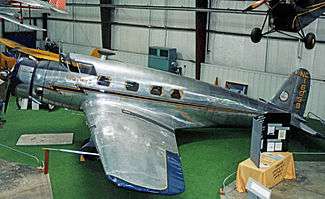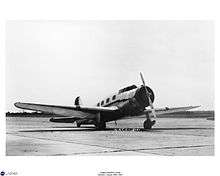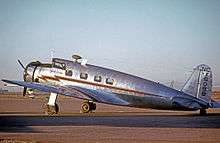Vultee V-1
| V-1 | |
|---|---|
 | |
| The sole V-1AD Special owned by Randolph Hearst and now preserved in the Virginia Aviation Museum. | |
| Role | Eight-passenger transport |
| Manufacturer | Airplane Development Corporation |
| Designer | Gerard Vultee |
| First flight | 19 February 1933 |
| Introduction | 1934 |
| Status | retired |
| Primary users | Spanish Republican Air Force American Airlines and LAPE |
| Produced | 1933-1936 |
| Number built | 25 (including prototype) |
|
| |
The Vultee V-1 was a 1930s American single-engined airliner built by the Airplane Development Corporation, designed by Gerard Vultee and financed by automobile manufacturer Errett Cord.[1]
Design and development
The prototype (designated the V-1) was an all-metal low-wing cantilever monoplane with a retractable tailwheel landing gear. It had accommodation for a pilot and six passengers and first flew on February 19, 1933.
The production aircraft were designated the V-1A and had a slightly larger and longer fuselage for two pilots and eight passengers. Production ended in 1936 after 24 aircraft plus the prototype had been built.[2]
A floatplane version, sold to the USSR along a manufacturing license was designated V-1AS and an executive transport version was designated V-1AD (for Deluxe). No production ensued in the USSR.
Operational history

American Airlines bought at least 13 V-1As and the V-1 prototype (after it had been modified for two pilot operation) and they entered service in 1934. On introduction, they were the fastest commercial airliners of their day. They were used on routes from the Great Lakes to Texas. Bowen Airlines of Texas also operated the type.[3] By 1936, they were sold, having been replaced with twin-engined aircraft when the Bureau of Air Commerce severely limited the use of single engine airliners.
V-1ADs were operated by several private companies or individuals as high-speed executive aircraft. The sole V-1AD Special was used prewar by newspaper magnate Randolph Hearst. It later served airlines in Panama and Nicaragua before returning to the United States postwar.[4]
Fitted with twin floats and extra fuel tanks, the sole V-1AS Special was sold to the Soviet Union and used for a 10,000 mile Santa Monica to Moscow flight.
A V-1AD was used in 1936 during an attempt at the first New York-London-New York double crossing, flown by Harry Richman and Henry T. "Dick" Merrill, in the famous "Ping Pong" flight, when to ensure buoyancy in case of ditching, empty spaces in the aircraft were filled with ping pong balls.[5] It was later used by Nationalist forces in Spain as a transport and high speed bomber.
Seven former American Airlines aircraft, plus eight others were used by the Republicans in the Spanish Civil War, with machine guns and under-fuselage bomb racks fitted. Four of the aircraft were captured by the Nationalists.[6]
The V-1 was used in the filming of Jungle Queen (1944) with Clark Gable, and The Tarnished Angels (1957).[7]
Variants
- V-1
- Prototype with a 650 hp (485 kW) Wright SR-1820-F2 Cyclone engine, one built, later modified to V-1A standard before delivery to American Airlines.
- V-1A
- Production variant with two crew and a 735 hp (548 kW) Wright Cyclone R-1820-F2 radial engine, 18-built and one converted from prototype.
- V-1AD
- Deluxe executive variant with a 850 hp (634 kW) Wright Cyclone R-1820-G2 radial engine,, six built.
- V-1AD Special
- As V-1AD but fitted with a 1,000 hp (746 kW) Wright Cyclone R-1820-G2 radial engine, one built.
- V-1AS Special
- Special variant with either 775 hp (578 kW) R-1820-F52 or 850 hp (634 kW) R-1820-G2 radial engine, with twin floats, one built for the Russian government.
Survivors

The V-1AD Special NC16099 is the sole survivor of the type and is preserved on public display at the Virginia Aviation Museum at Richmond Airport, Virginia[4] and is painted as Lady Peace II to commemorate the original Lady Peace used for the double crossing attempt. It was restored and flown in 1971 by Harold Johnston from Colorado.[8]
Operators
- Spanish Republican Air Force - Republican Spain purchased 16 V-1s from various sources, including 10 from American Airlines. At least one was destroyed by sabotage before delivery and four more were seized by Nationalists during delivery.[9]
Civil operators
- American Airlines (1 V-1 and 10 V-1A)[10]
- Bowen Airlines[10]
- Crusader Oil Corporation[12]
- William Randolph Hearst[12]
Specifications (V-1A)
Data from General Dynamic Aircraft and their Predecessors[9]
General characteristics
- Crew: 2
- Capacity: 8 passengers
- Length: 37 ft 0 in (11.28 m)
- Wingspan: 50 ft 0 in (15.24 m)
- Height: 10 ft 2 in (3.10 m)
- Wing area: 348 ft2 (32.3 m2)
- Empty weight: 5,332 lb (2,424 kg)
- Gross weight: 8,500 lb (3,864 kg)
- Powerplant: 1 × Wright Cyclone R-1820-F2, 735 hp (548 kW) each
Performance
- Maximum speed: 235 mph (378 km/h)
- Cruise speed: 215 mph (346 km/h)
- Range: 1,000 miles (1,610 km)
- Service ceiling: 20,000 ft (6,100 m)
- Rate of climb: 1,000 ft/min (5.1 m/s)
See also
- Related development
- Aircraft of comparable role, configuration and era
- Breese-Dallas Model 1
- General Aviation GA-43
- Junkers Ju 160
- Lockheed Vega
- Manshū Hayabusa
- Northrop Delta
References
Notes
- ↑ Parker, Dana T. Building Victory: Aircraft Manufacturing in the Los Angeles Area in World War II, p. 107, Cypress, CA, 2013. ISBN 978-0-9897906-0-4.
- ↑ Pattillo 2001, p. 80.
- ↑ Davies 1998
- 1 2 Ogden 2007
- ↑ "Transatlantic Types." Time magazine via time.com, September 28, 1936. Retrieved: December 31, 2010.
- ↑ "1936 Vultee V1-A." The Virginia Aviation Museum. Retrieved: August 1, 2010.
- ↑ Air Progress. September 1971. Missing or empty
|title=(help) - ↑ Air Progress: 16. September 1971. Missing or empty
|title=(help) - 1 2 3 Wegg 1990, p. 155.
- 1 2 3 Wegg 1990, p. 153.
- ↑ Andersson 2008, p. 289.
- 1 2 Wegg 1990, p. 154.
Bibliography
- Andersson, Lennart. A History of Chinese Aviation: Encyclopedia of Aircraft and Aviation in China to 1949. Taipei, Republic of China:AHS of ROC, 2008. ISBN 978-957-28533-3-7.
- Davies, R.E.G. Airlines of the United States. McLean, Virginia: Paladwr Press Inc, 1998. ISBN 1-888962-08-9.
- The Illustrated Encyclopedia of Aircraft (Part Work 1982-1985). London: Orbis Publishing, 1985.
- King, Jack. Wings of Man: The Legend of Dick Merrill. Seattle: Aviation Book Co., 1981. ISBN 0-911721-91-6.
- Ogden, Bob. Aviation Museums and Collections of North America. Tonbridge, Kent: Air-Britain (Historians) Ltd, 2007. ISBN 0-85130-385-4. Page 541.
- Pattillo, Donald M. Pushing the Envelope: The American Aircraft Industry. Ann Arbor, Michigan: University of Michigan Press, 2001. ISBN 978-0-47208-671-9.
- Richard, Allen S. "Jerry Vultee's V1." Air Classics Magazine, Challenge Publications, June 1976.
- Wegg, John. General Dynamic Aircraft and their Predecessors. London: Putnam, 1990. ISBN 0-85177-833-X.
External links
| Wikimedia Commons has media related to Vultee V-1. |